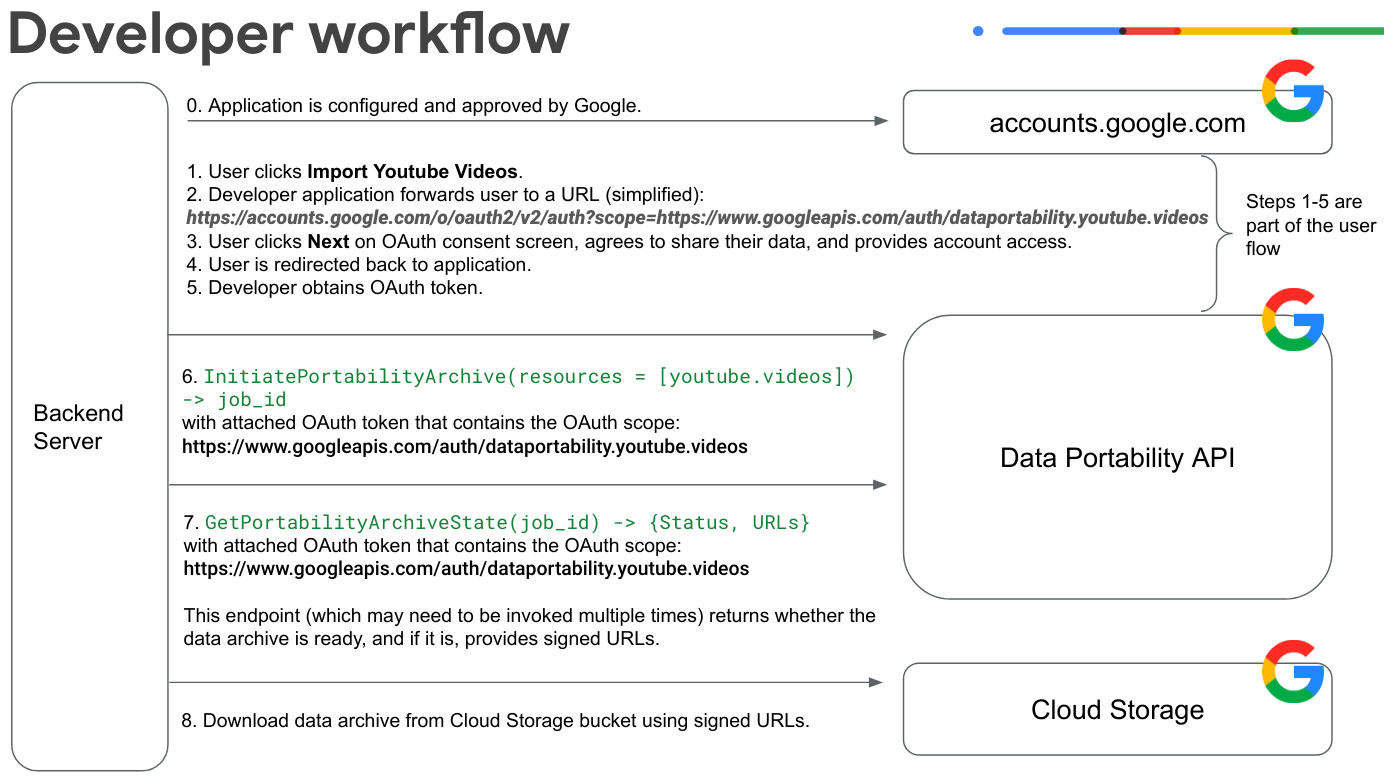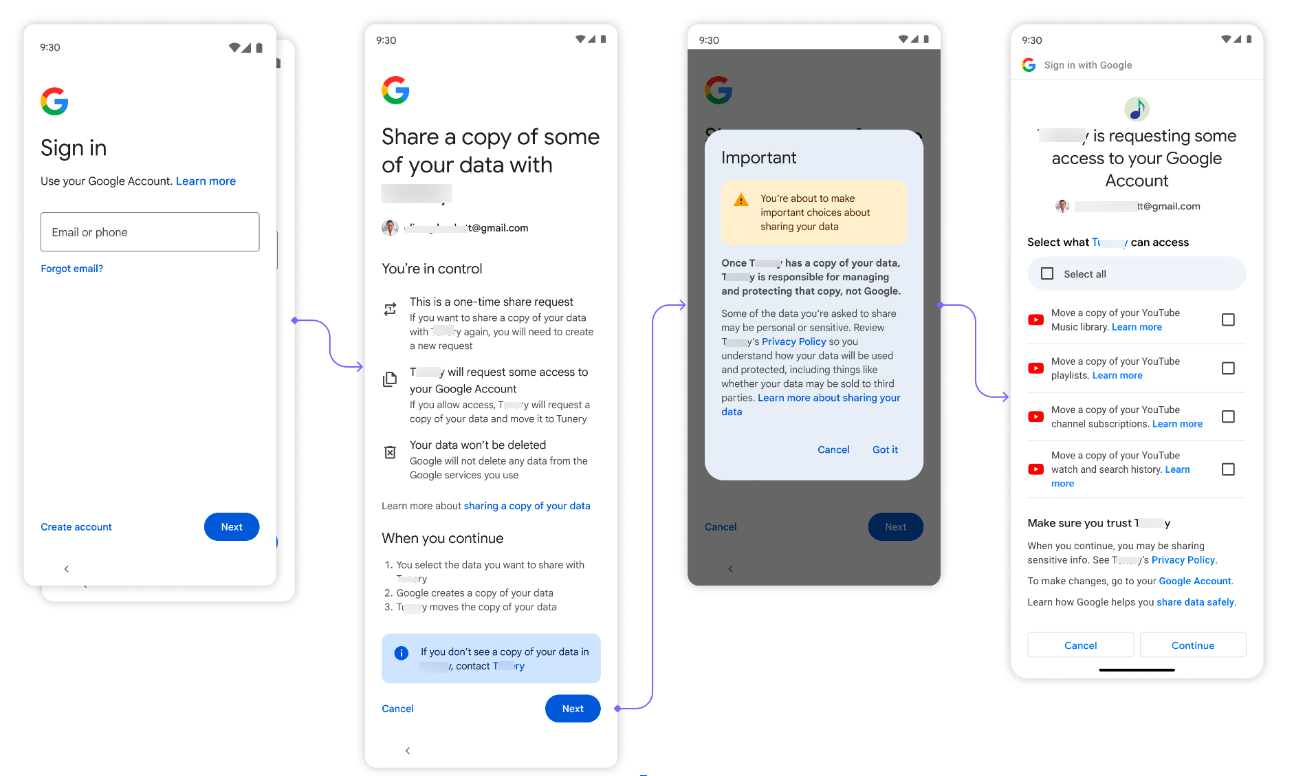Data Portability API를 사용하면 사용자에게 Google 서비스에서 애플리케이션으로 데이터 사본을 이동할 수 있는 승인을 요청하는 애플리케이션을 빌드할 수 있습니다. 이를 통해 데이터를 쉽게 이동하고 서비스를 쉽게 전환할 수 있습니다.
사용자가 데이터를 공유하는 방법에 관한 정보를 확인하려면 서드 파티와 데이터 사본 공유하기를 참고하세요.
기본 요건
앱을 출시하려면 먼저 Google의 승인을 받아야 합니다.
또한 사용자의 위치에서 Data Portability API를 사용할 수 있는지 확인해야 합니다. 지원되는 국가 및 지역의 목록은 '서드 파티와 데이터 사본 공유하기' 페이지의 일반 질문을 참고하세요.
개발자 워크플로
다음은 Data Portability API를 사용하는 애플리케이션을 만드는 단계입니다.

사용자를 위한 OAuth 동의 흐름을 구현합니다. 이 예에서는 사용자가 YouTube 동영상 데이터에 대한 액세스 권한을 제공하고 있습니다.
사용자가 YouTube 동영상 가져오기를 클릭하고 Google 계정에 로그인합니다.
앱이 사용자를 OAuth 동의 URL로 전달합니다. 이 URL 예시는 단순화되었으며 일부 매개변수가 누락되었습니다.
https://accounts.google.com/o/oauth2/v2/auth?scope=https://www.googleapis.com/auth/dataportability.myactivity.youtube사용자가 OAuth 동의 화면에서 다음을 클릭하고 데이터 공유에 동의한 후 계정 액세스 권한을 제공합니다.
사용자가 공유할 데이터와 앱이 해당 데이터에 액세스할 수 있는 시간 (데이터에 대한 일회성 액세스 또는 30일 또는 180일 동안의 시간 기반 액세스)를 선택한 다음 계속을 클릭합니다.
참고: OAuth 토큰이 만료되기 최대 90일 전에 사용자는 OAuth 토큰이 만료되기 전에 데이터에 대한 액세스 권한을 갱신할 수 있습니다. 사용자에게 90일 이내에 만료되는 범위가 없는 경우 갱신 버튼이 표시되지 않습니다.
참고: 사용자가 일회성 액세스와 시간 기반 액세스 간에 전환하려면 기존 부여가 취소된 후 동의 절차를 다시 거쳐야 합니다.
resetAuthorization()를 사용하여 부여를 취소하거나 사용자는 연결 페이지에서 취소할 수 있습니다.사용자가 앱으로 리디렉션됩니다.
개발자가 사용자의 OAuth 토큰을 가져옵니다.
앱이 다음 OAuth 범위가 포함된 연결된 OAuth 토큰으로
InitiatePortabilityArchive(resources = ["myactivity.youtube"])를 호출합니다.https://www.googleapis.com/auth/dataportability.myactivity.youtube이 호출은 데이터 보관 파일 생성 프로세스를 시작하고 작업 ID 및 사용자가 일회성 액세스 권한을 부여했는지 여부로 응답합니다.
참고: 일회성 액세스 권한은 범위당 하나의 내보내기를 의미합니다. 사용자가 여러 범위를 부여하는 경우 토큰으로 승인된 각 리소스에 대해 별도의 작업을 만들 수 있습니다.
앱이 다음 OAuth 범위가 포함된 첨부된 OAuth 토큰으로
GetPortabilityArchiveState(job_id)를 호출합니다.https://www.googleapis.com/auth/dataportability.myactivity.youtube이 메서드를 여러 번 호출하여 보관처리 작업의 상태를 가져올 수 있습니다. 이 메서드는 작업의 상태를 반환합니다. 상태가
COMPLETE이면 아카이브가 준비되고 서명된 Cloud Storage URL이 제공됩니다. 보관처리 요청을 완료하는 데 걸리는 시간은 데이터 크기에 따라 몇 분에서 몇 시간까지 걸릴 수 있습니다.서명된 URL을 사용하여 데이터 보관 파일을 다운로드합니다.
사용자가 일회성 액세스를 허용하는 경우 연결된 OAuth 토큰으로
ResetAuthorization()를 호출하여 소진된 리소스를 재설정하고 모든 OAuth 동의를 삭제합니다.사용자가 시간 기반 액세스 권한을 부여한 경우 동의가 만료될 때까지 24시간마다 리소스를 내보낼 수 있습니다.
Data Portability API 메서드 사용에 관한 자세한 내용은 Data Portability API 메서드 호출을 참고하세요.
사용자가 Data Portability API 앱과 상호작용하는 방식
이 다이어그램은 사용자가 Data Portability API와 통합된 앱과 상호작용하는 방식을 보여줍니다.

먼저 사용자에게 데이터를 검색할 수 있는 옵션이 표시됩니다.
그런 다음 사용자는 Google 계정에 로그인합니다.
그런 다음 사용자는 데이터 공유 메시지가 표시되면 다음을 클릭하고 개인정보처리방침 수락 메시지가 표시되면 이해했습니다를 클릭합니다.
그런 다음 사용자에게 애플리케이션이 사용자의 데이터에 액세스하도록 허용하는 데 사용되는 OAuth 동의 화면이 표시됩니다. 여기의 옵션은 구성한 OAuth 범위와 일치합니다. 사용자가 공유할 데이터와 앱이 해당 데이터에 액세스할 수 있는 시간 (데이터에 대한 일회성 액세스 또는 30일 또는 180일 동안의 시간 기반 액세스)를 선택한 다음 계속을 클릭합니다.
액세스를 허용하면 데이터 가져오기가 시작됩니다. 데이터 크기에 따라 요청을 완료하는 데 몇 분에서 몇 시간까지 걸릴 수 있습니다.
